Throwing someone out of a window may seem like a bizarre and archaic form of protest. However, throughout European history, this violent act was used more often than you would expect in hopes of achieving important social and political goals.
The word “defenestration” originates from the Latin word “fenestra,” meaning “window,” and “de,” a suffix indicating “from.” It comes from the 17th century, although the practice itself dates back even further. However, today, the word’s meaning has changed and is used to describe removing someone from power or a governmental position.
Yet, despite its obscure nature and the evolving usage of the word, the act of throwing someone from a window has had a lasting impact on history, especially in European politics. It would even lead indirectly to war on more than one occasion!
While defenestration is a topic that might at first appear to be of limited interest, its impact on society and history cannot be ignored. It hides a fascinating history, richer and more riveting than you would believe.
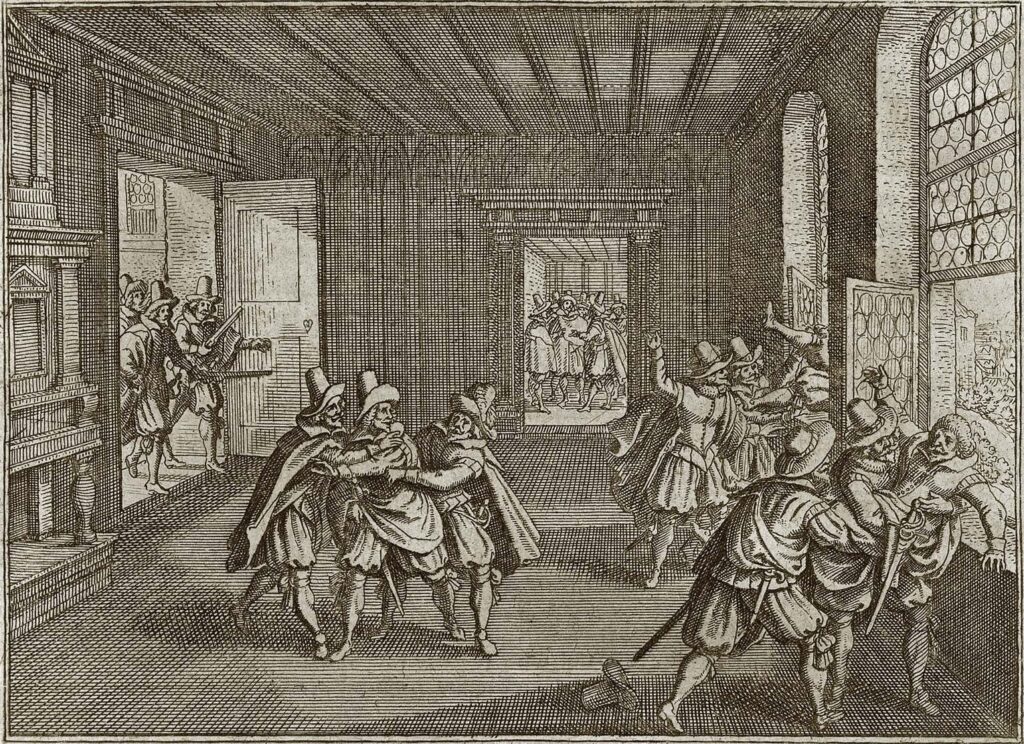
History’s First Known Defenestration
Although the concept of defenestration was acknowledged in 17th-century Prague, the violent practice dates back much further. The first known defenestration to be recorded and memorialized by history occurred around the 9th century BC, and it was the death of Queen Jezebel in the Bible.
According to the Hebrew Bible, Queen Jezebel was defenestrated by her eunuch servants at the urging of Jehu. She was the powerful wife of the King of Northern Israel, who ridiculed Commander Jehu from a window.
Enraged by her behavior, the commander ordered some of the servants who were standing near her to hurl Jezebel out of the window, murdering her. Dogs then mauled her body until, according to the story, there was nothing left apart from the bones.
In this biblical tale, Jezebel’s defenestration is not a random act, but rather a purposeful, legitimate form of punishment. The story even proclaims Jezebel’s grisly fate to be the fulfillment of a divine prophecy, and she is considered the epitome of evil in the Bible.
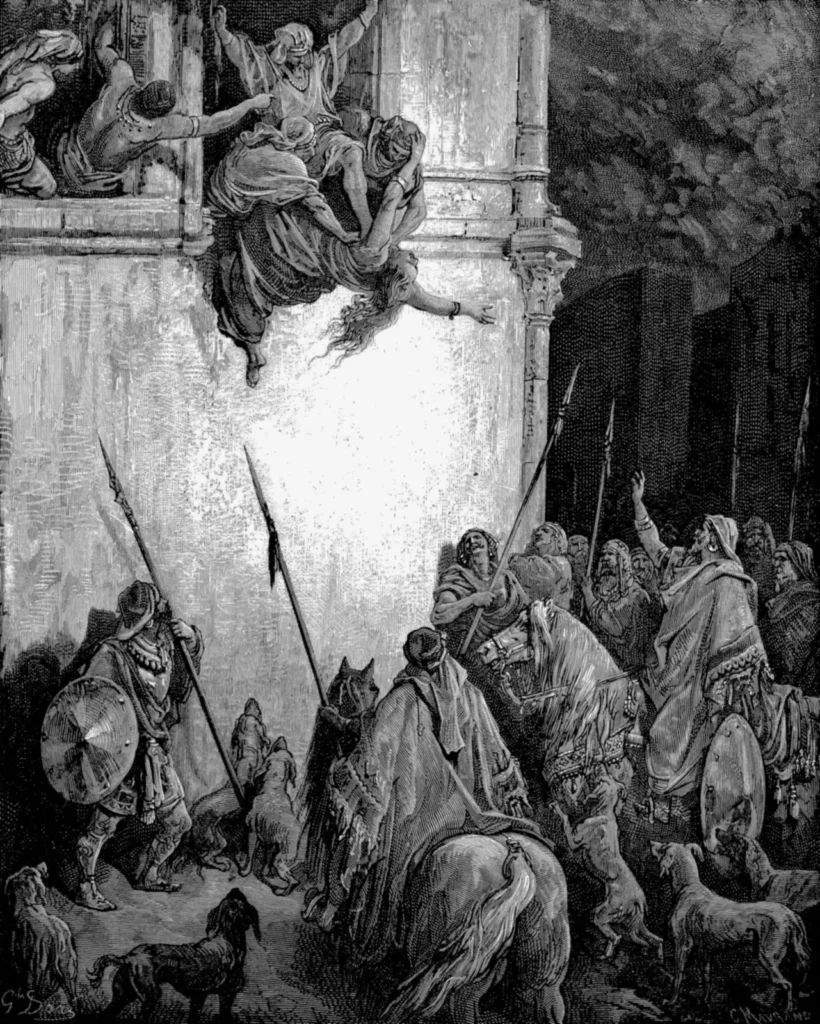
Long before the 17th century, and a product of the breadth of Christianity across Europe, many people were quite familiar with the biblical story of Jezebel. It was a common reference in discussions of false idols and debates between religious factions.
Notably, during the French Wars of Religions, the leading Catholic preachers of Paris compared the king and his powerful mother, Catherine de Medici, to King Ahab and Queen Jezebel from the Old Testament, suggesting that eventually, it would end very badly for them.
While the defenestration of Queen Jezebel may seem like an archaic, yet insignificant event, it was likely a key catalyst and influence behind the history of defenestration as a form of public punishment.
The First Defenestration of Prague
On July 30, 1419, an enraged group of radical Czech Hussites stormed the New Town Hall in Prague, killing over a dozen members of the city council by – you guessed it – throwing them out of the window. Little did the crowd know at the time, but the deadly act would not be the last time defenestrations rocked the city.
Tensions in Prague had been running high for quite some time and were the result of growing discontent among the Czech people over civil inequality and religious fervor. The Hussites – named for the religious reformer Jan Hus – had grown especially rebellious after Hus’ execution in 1415. And years later, by 1419, the situation was worsening.
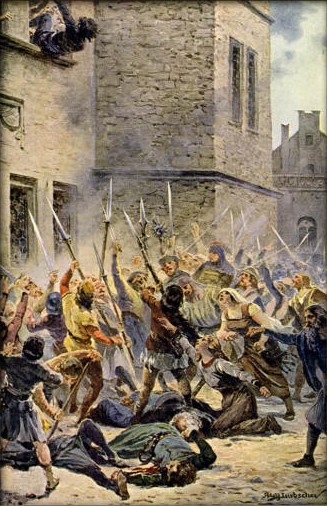
Led by Jan Želivský, a Hussite priest at the Church of Virgin Mary of the Snows, the protest started by demanding the release of imprisoned supporters.
The vicious mob then marched on the town hall, but when the councilors refused to release them, the crowd stormed the building. The councilors were then thrown out of the windows and onto the spears of the armed congregation below, brutally killing them.
This event, the so-called First Defenestration of Prague, marked a turning point in the Hussite movement, as it was the first violent act that would kickstart the Hussite Wars that lasted until 1436.
After the defenestration, the religious preachers, like Želivský, urged their congregations to take up arms, resulting in the violence and bloodshed that followed.
The Hussite movement, which emerged stronger after the First Defenestration, directly challenged the Catholic Church’s authority. It also inspired similar religious reforms across Europe and played a significant role in the Protestant Reformation.
Moreover, it directly challenged the authority – both the Catholic Church in Europe and the governmental powers of the region.
It demonstrated that religious reformers were ready to challenge the Church’s corruption, marking a turning point in European history and setting the stage for the Reformation. The city of Prague wasn’t finished with tossing the people in power out of windows.
Europe’s Most Famous Defenestration
The citizens of Prague quickly took to throwing city councilors out of the window any time they were angry. They were at it again in 1483. It would not be long before the most famous defenestration, the event that would coin the term of the act, which took place in 1618.
The Second Defenestration of Prague was a historic event that solidified the concept of defenestration in the annals of history and even precipitated the Thirty Years War some years later.
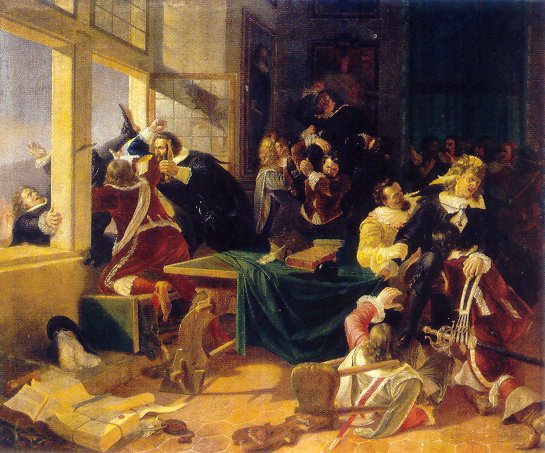
In 1617, Roman Catholic officials put a stop to the construction of some Protestant chapels in Prague, claiming that the land belonged to them.
Protestants did not take kindly to the move, seeing it as a violation of their religious freedom, so they protested.
Tensions had already been high throughout the Hapsburg Empire under its Catholic aristocracy and rulers, and this protest only inflamed the situation.
On May 23, 1618, several Czech Protestants met intending to oust the imperial regents, Vilém Slavata of Chlum and Košumberk and Jaroslav Bořita of Martinice.
The enraged crowd marched to Prague Castle, where they were found guilty of violating the Right of Freedom of Religion.
Around 3 p.m., amidst the chaos and anger, the two imperial regents were ceremoniously thrown from the 16-meter-high windows of the castle to the ground below. Even their secretary wasn’t spared from the mob’s wrath.
Miraculously, they survived the towering fall, seemingly unharmed. Catholic supporters came to see their incredible survival as an act of God and the righteousness of their cause. But Protestants disagreed and contributed their survival to luck – and the pile of manure that supposedly broke their fall.
Although the men survived, the whole event would kickstart the Bohemian revolt against the Habsburg emperor, and pave the way for the Thirty Years’ War.
By challenging the authority of the Roman Catholic Church and highlighting the religious tensions between the Protestants and the Catholics, it provided a strong foundation for the revolts that followed.
The Global Capital of Defenestrations
Several other notable defenestrations have taken place throughout the city’s history, although they may not be referred to as “Defenestrations of Prague.” As mentioned, one such event occurred on September 24, 1483, between the ‘First’ and ‘Second’ Defenestrations.
The Hussites, feeling threatened by Catholics who dominated the Old Town Hall, overthrew the municipal governments of the Old, New, and Lesser Towns.
In the process, they threw an Old Town warden out of a window, as well as seven other councilors at the New Town. As a result, the king kept his distance from Prague for a year following the incident.
Another, more modern event, sometimes referred to as the “Third Defenestration of Prague,” also occurred. On March 10, 1948, Czechoslovakia’s Foreign Minister Jan Masaryk was found dead beneath the bathroom window of his residency at the Foreign Ministry.
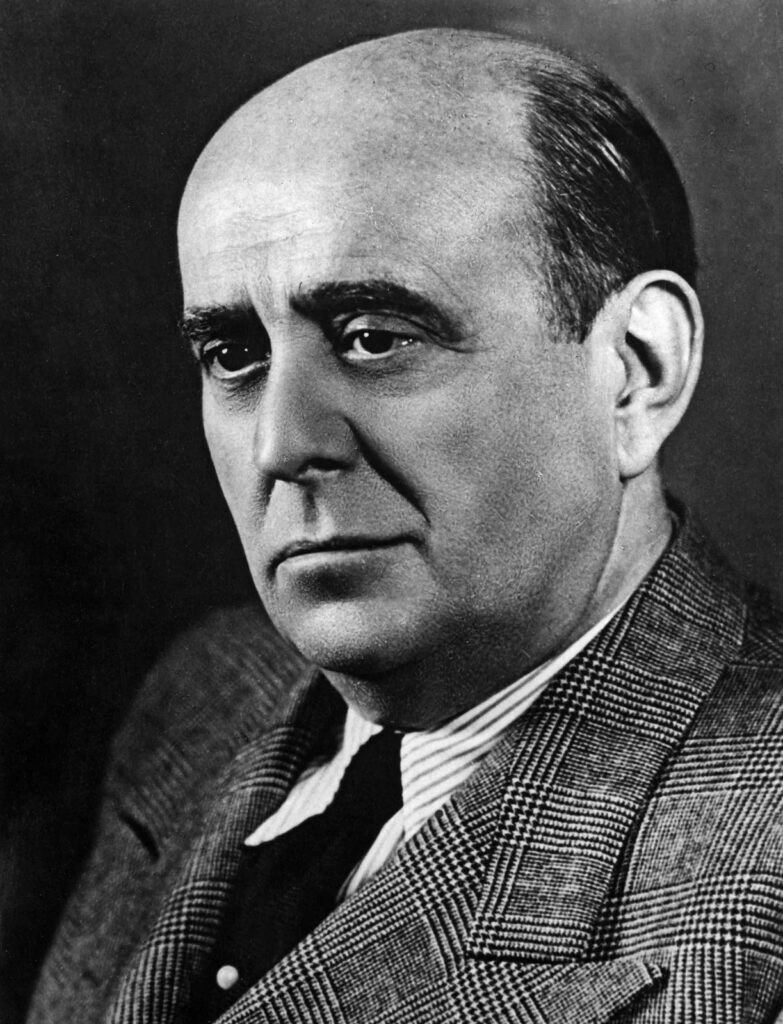
Although initially ruled a suicide, some speculated that a communist takeover and its agents aimed to defenestrate him. The investigation into his death was reopened multiple times, and in 2004, a police report suggested that at least one other person was involved in his death.
However, a subsequent investigation in 2019 judged that the involvement of other individuals could neither be confirmed nor denied and the final verdict was inconclusive. Masaryk’s death remains an intriguing, mysterious chapter in Prague’s long history of defenestration.
While not all defenestrations may be referred to as such, they all share similarities with the many incidents in Prague, specifically the throwing of individuals out of windows in a violent expression of political or religious discontent.
These events serve as reminders of the need for a peaceful resolution to conflicts, as they have happened many times throughout history, all over the world.
Other Notable Defenestrations in History
For such a unique, albeit unceremonious, form of murder, history is rife with incidents of defenestration.
In the 14th century, multiple defenestrations made the historical record. For instance, in 1378, in Belgium, the Defenestration of Leuven occurred when a group of patricians was thrown out of a city hall window by a furious crowd after they had a local leader assassinated. This resulted in at least 15 deaths.
Then in 1383, Bishop Dom Martinho was defenestrated by citizens of Lisbon who suspected him of conspiring with the enemy during the Castilian siege of the city.
Portuguese history seems particularly given to defenestration. Centuries later, in 1640, supporters of the Duke of Braganza party killed and defenestrated the Secretary of State Miguel de Vasconcelos in Lisbon, amongst a great deal of public indignation.
Elsewhere, it is believed that in 1452, King James II of Scotland murdered nobleman William Douglas, the 8th Earl of Douglas, with his own hands and defenestrated him at Stirling Castle. Defenestration at the hands of a king, rather than an angry mob, is certainly a unique and rare event in world history.
In more modern times, the practice has continued. On June 11, 1903, Serbian army officers murdered and defenestrated King Alexander and Queen Draga. And in 1968, Deng Pufang, the son of China’s future paramount leader Deng Xiaoping, was thrown from a window by Red Guards during the Cultural Revolution.
One should be especially wary of plummeting from a windowsill if they find themselves in trouble with Russian authority.
Russian investigative journalist Ivan Safronov was found dead in 2007 after falling from a fifth-floor window – he had reportedly been researching the Kremlin’s covert arms deals at the time. His friends and colleagues discounted suicide as a possibility, and an investigation was opened on the matter.
And most recently, on September 1, 2022, Ravil Maganov, chairman of Russia’s oil giant, Lukoil, and a critic of the country’s invasion of Ukraine, died after falling from a hospital window in Moscow – on the same day as a visit by Russian President Vladimir Putin, no less.
Many have hypothesized a connection with other peculiar deaths of Russian businessmen, but no concrete evidence as to whether these incidents can be classified as defenestrations exist.
The Legacy of Throwing Power out the Window
As the historical record shows, the legacy of defenestration is long and rich, full of kings, queens, angry mobs, and every location imaginable. But why was it such a popular form of protest and punishment?
There are many ways to kill, but the use of windows seems somewhat unusual. However, windows were likely considered to be sites of political self-presentation and ceremony, making them prime targets for displays of power and punishment.
In fact, throughout the early modern period, windows did become important sites for draconian acts of punishment, with defenestration being one of these, as the point was to cause public humiliation and dishonor. This desire for increased attention even led to elaborate bay windows of city halls being occasionally used as pillories, a further attempt at dishonoring the victim.
Defenestration has a rich, complex history that continues to intrigue scholars and historians to this day. It was often used as a symbolic and ritualistic act of violence in various contexts, including political, religious, and social.
However, defenestration wasn’t always carried out by angry mobs but sometimes even by monarchs themselves, demonstrating the extreme measures people will go to make their voices heard and their power felt. Defenestration’s legacy is a reminder of the power of violence and the lengths people will go to achieve their goals.

